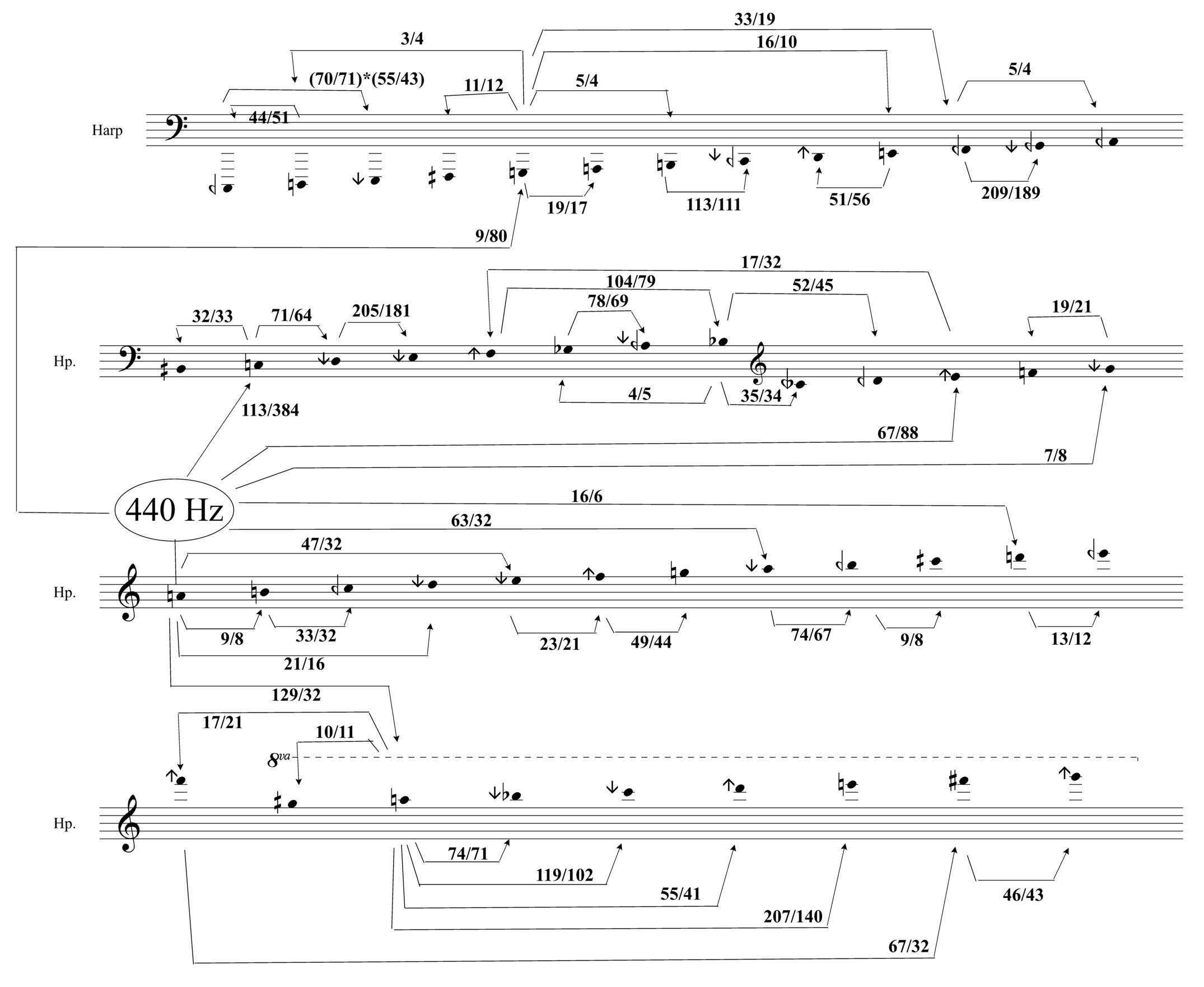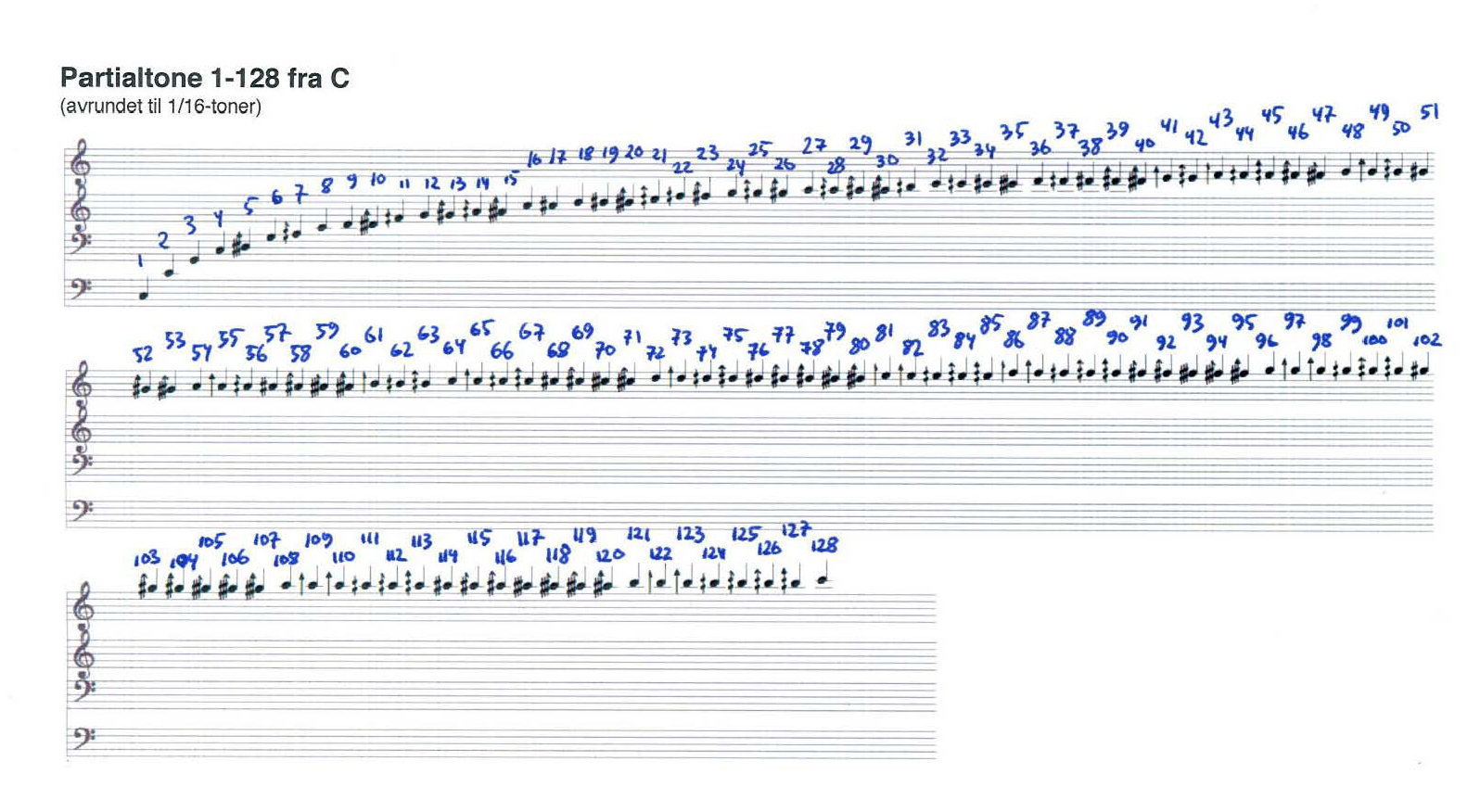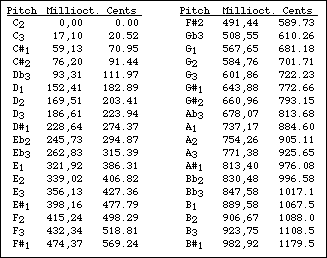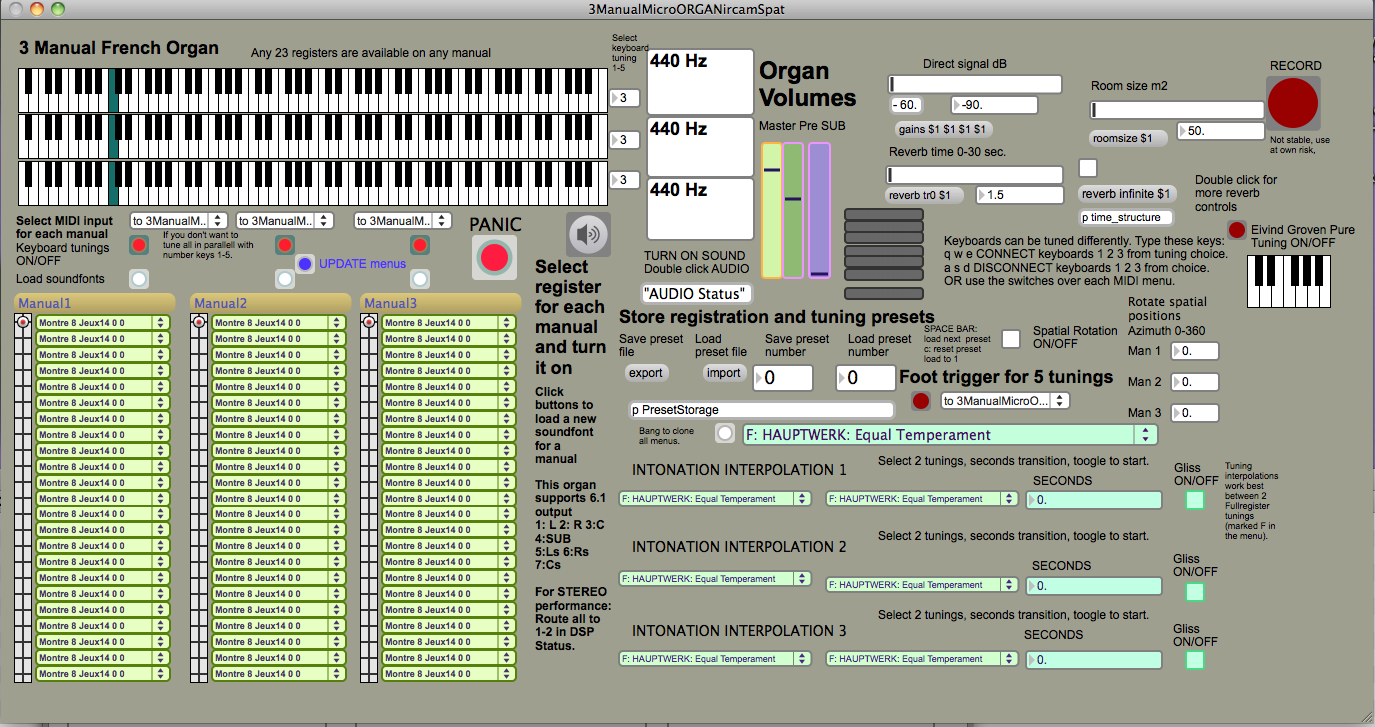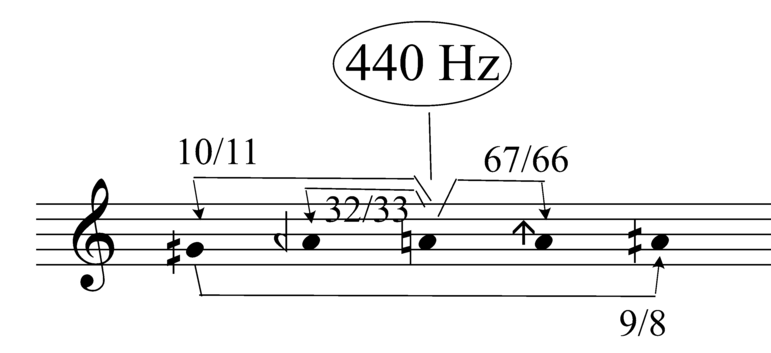3 Manual Microtonal Organ
A software organ was developed for experiments with historical and new tuning systems. Details are avaiable in the pdf documentation. Below are some of the most important tuning methods used in the final work.
Building new scales from javanese intervals
Random slendro
Javanese gamelan ensembles all have their own tuning variations. If a 5-note slendro mode was built just by an interval of 240 cents, the octave would be divided into 5 equal parts. I find the shimmering quality of the detuned octaves especially interesting, and this has been a criteria for this selection. By including the irregular variations of the slendro interval, mentioned above, we will have this reservoir or intervals:
268 286[1] 235 245 230 238 257 235 237 233 232 250 240 254 273 236 224 258 256 218 255 248 233 259 245 237
The 50 random slendro tunings are built from random stackings of these intervals. This will create unique tunings, which can be explored one by one.
Intervals from the same reservoir are stacked to create 5 different keyboard tunings. This kind of transposition it not available within a single gamelan set. This transposition could be compared to bringing several different gamelan sets together.
Random pelog
The pelog scales have 7 notes, even though gamelan pieces may use only 5 of these. As this scale is build of smaller and larger intervals, not roughly equal steps like in slendro, I will make a distinction between the different steps of these scales. This reservoir of intervals can create new modes rich of detuned octaves.
Pelog step 1
120 110 120 141 139 110 202 120 120 132 128 126 158 136 138 132 130
Pelog step 2
150 150 138 141 128 153 133 138 146 154 166 136 162 142 140 126
Pelog step 3
266.5 255 281 200 336 253 147 281 284 272 254 266 270 294 292 268
Pelog step 4
130.5 140 135 212 99 55 183 136 126 130 180 140 116 118 120 112
Pelog step 5
113 115 110 115 94 205 196 110 108 110 102 110 102 106 108 96 108
Pelog step 6
167.5 190 158 172 173 179 158 206 198 176 198 214 204 208 224 206
Pelog step 7
251 240 263 246 231 174 263 220 242 220
The 50 included random pelog tunings, are in fact 250 variations, as each tuning includes 5 variations selected by triggers.
Melodyne tunings
The software Melodyne[2] offers the possibility to retune recordings to a pitch grid. A number of tunings are included as possible pitch grids. I have included these same tunings in my library and credit Melodyne as the source.
These include pelog and slendro scales, turkish commas and modes, Bohlen-Pierce scale, and the tunings of a number of asian and african instruments. Scales are stacked to fill the whole keyboard.
Eivind Groven pure tuning organ
The Eivind Groven pure tuning organ will require a different programming, as intonation is adjusted after pitches being performed. A software version of this is freely available for download from Notam.[3] My own implementation of this has been made through study of information published by David Loberg Code,[4] and the functionality of the Notam patch. Adding the Groven system to this 3 Manual Microtonal organ adds the possibility to combine multiple organ stops. This table is found at the Code website:
The Groven system consists of 36 tones, where notes are selected by what notes are being performed. Each of the 12 tones has 3 possible intonations (ex. B#1, C2, C3).
Studying the behavior of the Notam patch, I have notated rules into a dictionary file named GrovenSetChords.json:
{
"C-dur" : [ "0 4 7", "C2 G2 E1" ],
"Db-dur" : [ "1 5 8", "Db3 F2 Ab3" ],
"D-dur" : [ "2 6 9", "D2 F#2 A2" ],
"Ess-dur" : [ "3 7 10", "Eb3 G2 Bb3" ],
"E-dur" : [ "4 8 11", "E2 G#2 H3" ],
"F-dur" : [ "0 5 9", "F2 A1 C2" ],
"F#-dur" : [ "1 6 10", "Gb3 Bb2 Db3" ],
"G-dur" : [ "2 7 11", "G2 H2 D2" ],
"Ab-dur" : [ "0 3 8", "Ab3 C2 Eb3" ],
"A-dur" : [ "1 4 9", "A2 C#2 E2" ],
"Bb-dur" : [ "2 5 10", "Bb2 D1 E#1" ],
"H-dur" : [ "3 6 11", "H3 Eb2 Gb3" ],
"C-ters" : [ "0 4", "C2 E1" ],
"Db-ters" : [ "1 5", "Db3 F2" ],
"D-ters" : [ "2 6", "D2 F#2" ],
"Ess-ters" : [ "3 7", "Eb3 G2" ],
"E-ters" : [ "4 8", "E2 G#2" ],
"F-ters" : [ "5 9", "F2 A1" ],
"F#-ters" : [ "6 10", "Gb3 Bb2" ],
"G-ters" : [ "7 11", "G2 H2" ],
"Ab-ters" : [ "0 8", "Ab3 C2" ],
"A-ters" : [ "1 9", "A2 C#2" ],
"Bb-ters" : [ "2 10", "Bb3 D2" ],
"H-ters" : [ "3 11", "H3 Eb2" ],
"C-kvint" : [ "0 7", "C2 G2" ],
"Db-kvint" : [ "1 8", "Db3 Ab3" ],
"D-kvint" : [ "2 9", "D2 A2" ],
"Ess-kvint" : [ "3 10", "Eb3 Bb3" ],
"E-kvint" : [ "4 11", "E2 H3" ],
"F-kvint" : [ "0 5", "F2 C2" ],
"F#-kvint" : [ "1 6", "Gb3 Db3" ],
"G-kvint" : [ "2 7", "G2 D2" ],
"Ab-kvint" : [ "3 8", "Ab3 Eb3" ],
"A-kvint" : [ "4 9", "A2 E2" ],
"Bb-kvint" : [ "5 10", "Bb2 F2" ],
"H-kvint" : [ "6 11", "H3 Gb3" ],
"C-liten-6" : [ "0 8", "C2 Ab3" ],
"C#-liten-6" : [ "1 9", "C#2 A2" ],
"D-liten-6" : [ "2 10", "D2 Bb3" ],
"Ess-liten-6" : [ "3 11", "Eb2 H3" ],
"c-moll" : [ "0 3 7", "C2 Eb3 G2" ],
"c#-moll" : [ "1 4 8", "C#2 E2 G#2" ],
"d-moll" : [ "2 5 9", "D1 F2 A1" ],
"ess-moll" : [ "3 6 10", "Eb2 Gb3 Bb2" ],
"e-moll" : [ "4 7 11", "E1 G2 H2" ],
"f-moll" : [ "0 5 8", "F2 Ab3 C2" ],
"f#-moll" : [ "1 6 9", "Gb3 A2 Db3" ],
"g-moll" : [ "2 7 10", "G2 Bb3 D2" ],
"g#-moll" : [ "3 8 11", "G#2 H3 Eb2" ],
"a-moll" : [ "0 4 9", "A1 C2 E1" ],
"bb-moll" : [ "1 5 10", "Bb2 Db3 F2" ],
"h-moll" : [ "2 6 11", "H2 D2 F#2" ]
}
A problem with this is that, in the software version, a chord will only be pure the second time it is performed. This assumes the music has a stable tonality based on major and minor chords.
Harmonic series
The theoretical harmonic series can be calculated as
Fundamental Hz * n partial.
This forms the basis for pure tunings. An approximated notation of partials 1-128 of a deep C can be helpful for identifying just intonation intervals:
Spectrums of instruments or noises
A number of sounds have been analyzed through Open Music and Pm2[5]: Airplane cabin, thunder, thai gong, crushtones of viola and cello, goose, grasshoppers, breaking glass, cash machine, contrabass clarinet, tam-tams performed with various sticks and techniques.
Performing on these can show that the more noisy sounds have much less resonant spectrums. Playing clusters of these spectrums with soft organ registers can be a form of synthesis.
Rubens old just intonation scale
This is an attempt from around 1999 to find a just intonation scale for electroacoustic music, with a very pure C major and an out of tune A flat major.
The scale as multiplication
1 1.0625 1.125 1.1666666667 1.25 1.333333333 1.4 1.5 1.6 1.684210526 1.777777778 1.894736842
The scale as deviations from equal tempered tuning (from c to c)
0 4.955406 3.91 -33.128632 -13.686279 -1.955414 -17.487854 1.955017 13.68634 2.487488 -3.909729 6.397095 0
The scale in a 0-1200 cents notation
0 104.955406 203.91 266.871368 386.313721 498.044586 582.512146 701.955017 813.68634 902.487488 996.090271 1106.397095 0
This scale is transposed to 5 parallel concert pitches starting upwards from 450 Hz. Thereby comes my choice to create an instrument with 5 parallel tunings. The difference between lower and upper concert pitch is about a minor third. This is thus not a fine tuning, but a transposing intonation system.
These are the functions for deep fundamentals for each concert pitch:
igr1=(440*90)/5632
igr2=(440*9)/512
igr3=(440*297)/16384
igr4=(440*135)/7168
igr5=(440*117)/6144
The 5 concert pitches approximated and transposed to the middle octave:
1: 450 Hz
2: 495 Hz
3: 510.46875 Hz
4: 530.357117 Hz
5: 536.25 Hz
First version of the harp part in Grains
The work on Grains for harp, percussion and viola started in 2002. The first version required a complete retuning of the harp by overtone ratios. A tuning with no octaves and all unique pitches could make us reconsider the harp as a diatonic instrument. This idea was given up for practical reasons. This microtonal organ offers a possibility to test how this tuning would have worked.
This is the first tuning suggestion for the harp (tuned with pedals in middle positions):
Chromatic expansion of the Grains tuning (2011)
Having tried out the first harp tuning for Grains I have found it best suited for folk music improvisations, as it is diatonic, have the characteristic stretced octaves and variable overtone intonations. With a microtonal organ, this can be expanded to a chromatic version. In this case we have the whole keyboard covered.
Keyboard bendings
The whole tuning system can be transposed to concert pitches around from 440 Hz, related by overtone ratios:
[1] The interval 286 cent is not present in the slendro sources, but has been kept to create more irregularities. The random tunings are made as creative reinterpretations of the preceding musicological information.
[5] Both available from Ircam.
http://repmus.ircam.fr/openmusic/home
http://forumnet.ircam.fr/product/openmusic-libraries/



